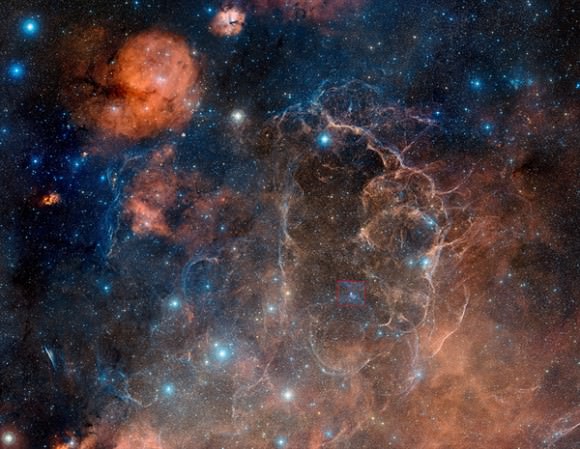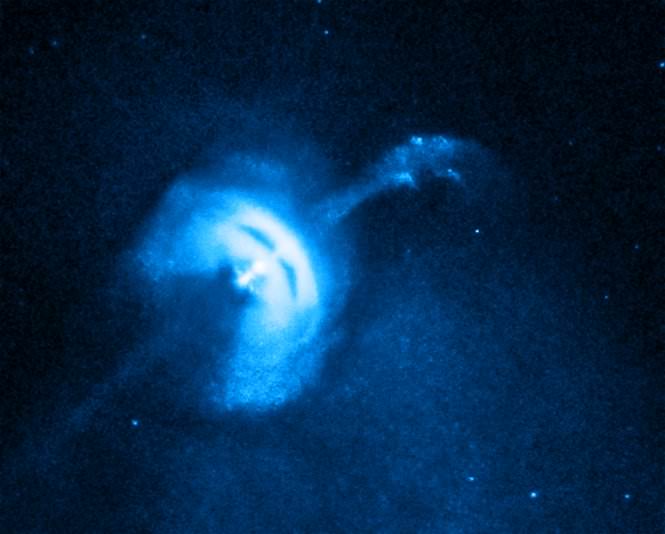This incredible new movie of the Vela pulsar has the unnerving appearance of the Phantom of the Opera – wearing not only a mask, but also a steam-blowing hat like the Tin Man in “The Wizard of Oz.” What you are seeing here are observations from the Chandra X-ray Observatory, showing a fast moving jet of particles produced by a rapidly rotating neutron star. Scientists say these observations may provide new insight into the nature of some of the densest matter in the universe.
The Vela pulsar is about 1,000 light-years from Earth, about 19 km (12 miles) in diameter, and makes a complete rotation in 89 milliseconds. As the pulsar whips around, it spews out a jet of charged particles that race along the pulsar’s rotation axis at about 70 percent of the speed of light. The Chandra data used in the movie were obtained from June to September 2010, and it may suggest the pulsar may be slowly wobbling, or precessing, as it spins. The period of the precession, which is analogous to the slow wobble of a spinning top, is estimated to be about 120 days.
“We think the Vela pulsar is like a rotating garden sprinkler — except with the water blasting out at over half the speed of light,” said Martin Durant of the University of Toronto in Canada, who is the first author of the paper describing these results.
The eight images shown in the movie suggest that the pulsar may be slowly wobbling, or precessing, as it spins. If the evidence for precession of the Vela pulsar is confirmed, it would be the first time that a jet from a neutron star has been found to be wobbling, or precessing, in this way.
One possible cause of precession for a spinning neutron star is that it has become slightly distorted and is no longer a perfect sphere. This distortion might be caused by the combined action of the fast rotation and “glitches”, sudden increases of the pulsar’s rotational speed due to the interaction of the superfluid core of the neutron star with its crust.
A paper describing these results will be published in The Astrophysical Journal on January 10, 2013.
This is the second Chandra movie of the Vela pulsar. The first one, released in 2003, looks like a Halloween Jack-o-lanatern gone wrong:
This movie contains shorter, unevenly spaced observations so that the changes in the jet were less pronounced and the authors did not argue that precession was occurring. However, based on the same data, Avinash Deshpande of Arecibo Observatory in Puerto Rico and the Raman Research Institute in Bangalore, India, and the late Venkatraman Radhakrishnan, argued in a 2007 paper that the Vela pulsar might be precessing.
The Earth also precesses as it spins, with a period of about 26,000 years. In the future Polaris will no longer be the “north star” and other stars will take its place. The period of the Vela precession is much shorter and is estimated to be about 120 days.

The supernova that formed the Vela pulsar exploded over 10,000 years ago. This optical image from the Anglo-Australian Observatory’s UK Schmidt telescope shows the enormous apparent size of the supernova remnant formed by the explosion. The full size of the remnant is about eight degrees across, or about 16 times the angular size of the Moon. The square near the center shows the Chandra image with a larger field-of-view than used for the movie, with the Vela pulsar in the middle.

Source: NASA


This is so super neat, but that’s just a regular mask, not a Phantom of the Opera mask. The Phantom’s mask only covered part of his face, y’all!
There were parts of the movie where he had another mask that covered both his eyes and resembles that mask. Although for most of the movie he had the mask you are talking about.
That’s the design of Leroux’s original mask. The play changed it to only one side of his face because the actors couldn’t see properly with the original mask design. Then the movie did the half-mask and the full mask.
Very cool! Kind of sad that it is 1000 light years away. Wonder what it’s actually like right now.
Phantom of the Opera? Really Nancy? This clip is cool enough to stand on its own. If you are so bored with the subject you write about that you have to resort to movie analogies, then maybe you need to find a new line of work.
Bored, are ye?
The lower jet seems to organize periodically into a double-helix-like configuration… (paused intermittently and in still frames you will find it repeats)
i think the helical structures are magnetic artifacts and could cause some pulsars to emit harmonics depending on the incident viewing angle.
Very cool…
I presume there is an accretion disk around the neutron star that provides the material for the jet.
LC
good question. i wonder if those are bow shocks from the object moving through material. maybe that’s where it could get some of it.
Jet`s are probably magnetically driven and don`t need accretion. Same story as with BH – we assume that material from acretion disc is needed because of BH properties (i.e event horizon)
There has to be a source for the gas that composes the jet.
LC
These particles could come directly from the neutron star.
It may have escaped your attention, but the surface gravity on a neutron star is about a trillion times the gravity on Earth. It is a bit hard to see how material on the surface is somehow hurled into space.
LC
I`m aware of it that`s why I mentioned BH. The true is that we don`t know much about these extreme bodies. All is theory. We don`t even know if neutrons in such star not decaying into quarks (same story with regular matter inside BH).
An accretion disk formed by infalling dust from polar plasm ejection fountains? ACK!
The idea that this pulsar is ejecting matter at either end of its axial poles is VERY similar to the recent ALMA observations of planet forming gas being ejected by the star HD 142527. The similarity is that the matter is being ejected by a processing polar axis. A similar mechanism? http://www.eso.org/public/news/eso1301/
These phenomena appear to be a gravitationally induced multi dimensional vortex pouring energy into our local space-time? As that energy slows below the speed of light it is spun up into gravitationally condensed whirlpools of annihilating matter and anti matter – the dust that is created or left over by that annihilation is then ejected?
A similar mechanism occurring all the way from the quantum to galactic scale? How like a naturally occurring fractal is that?
Multidimensional? When you hear hoof beats, think horses not zebras.
Like up/down, left/right, in/out, at the same TIMe, then BIG/Small! Scalar manifestations of empty space, time and energy? Is there an ’empty space’? Or is that a POV opine? For all we know…. a blink of the eye at relativistic speeds is still a wink!
When you hear hoof beats, think horses not zebras.
It may well still be doing it…